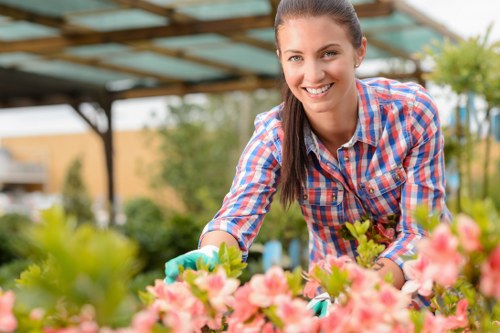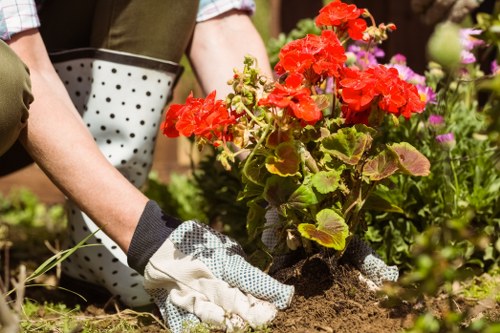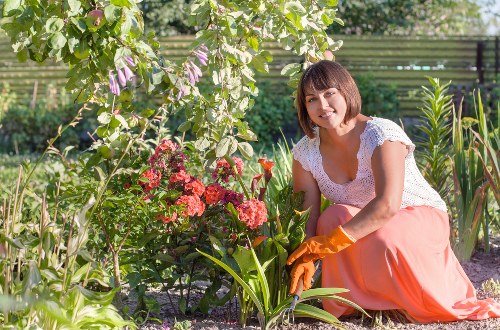Gardener Dartmouth Park: Nurturing Green Spaces in Your Community

Maintaining a beautiful garden in Dartmouth Park requires skill, dedication, and a deep understanding of the local environment. Whether you're a seasoned gardener or just starting out, having the right support can make all the difference. This article explores the essential aspects of being a gardener in Dartmouth Park, offering tips, insights, and local knowledge to help you cultivate a thriving garden.
Gardening in Dartmouth Park is not just a hobby; it's a passion that brings together residents and enhances the community's natural beauty. From selecting the right plants to managing seasonal changes, a gardener in this area plays a crucial role in creating and maintaining lush, vibrant spaces.
One of the key challenges gardeners face in Dartmouth Park is the variable climate. Understanding the local weather patterns and how they affect plant growth is essential. By choosing plants that are well-suited to the area's conditions, gardeners can ensure their gardens flourish year-round.
Understanding the Local Climate

Dartmouth Park experiences a temperate climate, characterized by mild winters and warm summers. This climate is ideal for a wide variety of plants, but it's important to select species that can thrive in these conditions. Hardy perennials, drought-tolerant shrubs, and seasonal flowers are popular choices among local gardeners.
Rainfall in the area is relatively evenly distributed throughout the year, reducing the need for excessive watering. However, during the summer months, occasional dry spells may require additional irrigation. Implementing sustainable watering practices, such as rainwater harvesting and mulching, can help conserve water and support plant health.
Frost can occasionally impact plant survival during the colder months. Protecting sensitive plants with frost covers or relocating them to sheltered areas can mitigate damage. Additionally, selecting frost-resistant varieties ensures your garden remains resilient against unexpected temperature drops.
Choosing the Right Plants

Selecting the appropriate plants is fundamental to creating a successful garden in Dartmouth Park. Native plants are an excellent choice as they are adapted to the local environment, requiring less maintenance and resources. They also support local wildlife, promoting biodiversity within the community.
Flowering plants such as roses, lavender, and daisies add color and fragrance to gardens, enhancing their aesthetic appeal. These plants are not only visually pleasing but also attract pollinators like bees and butterflies, contributing to the ecosystem's health.
Vegetable gardening is another rewarding aspect for residents interested in growing their own produce. Tomatoes, herbs, and leafy greens are popular choices, offering both beauty and functionality. Raised beds and container gardening are effective methods for maximizing space and ensuring optimal soil conditions for vegetable growth.
Soil Management and Fertilization

Healthy soil is the foundation of a thriving garden. Conducting a soil test helps determine its pH level and nutrient content, guiding gardeners in making informed decisions about amendments. Incorporating organic matter, such as compost or well-rotted manure, improves soil structure and fertility.
Proper fertilization supports plant growth by providing essential nutrients. Using slow-release fertilizers ensures a steady supply of nutrients over time, reducing the risk of over-fertilization and plant stress. Organic fertilizers, like bone meal or fish emulsion, offer a natural alternative to synthetic options.
Mulching serves multiple purposes in soil management. It helps retain moisture, suppress weeds, and regulate soil temperature. Organic mulches, such as bark or straw, also contribute to soil health as they decompose, enriching the nutrient content.
Irrigation Techniques

Efficient irrigation is crucial for maintaining a healthy garden, especially during dry spells. Drip irrigation systems deliver water directly to the plant roots, minimizing evaporation and reducing water waste. This method ensures that plants receive consistent moisture without overwatering.
Installing a rainwater harvesting system allows gardeners to collect and store rainwater for later use. This sustainable practice not only conserves water but also provides a free, natural source of hydration for plants. Integrating rain barrels with existing irrigation systems can enhance water efficiency.
Watering schedules should be adjusted based on seasonal changes and rainfall patterns. Early morning watering reduces evaporation rates and helps prevent fungal diseases by allowing foliage to dry during the day. Monitoring soil moisture levels ensures that plants receive the right amount of water without becoming waterlogged.
Pest and Disease Management

Protecting plants from pests and diseases is a vital aspect of gardening. Regular inspections help identify issues early, allowing for timely intervention. Integrated pest management (IPM) strategies combine biological, cultural, and chemical methods to control pests sustainably.
Encouraging natural predators, such as ladybugs and birds, helps maintain a balanced ecosystem within the garden. Companion planting, where certain plants are grown together to deter pests, is an effective preventive measure. For example, marigolds can repel nematodes, while basil deters aphids.
Using organic pesticides minimizes environmental impact and promotes a healthier garden. Neem oil, insecticidal soap, and diatomaceous earth are popular choices for managing pests without harming beneficial insects or polluting the soil.
Pruning and Maintenance

Regular pruning is essential for maintaining plant health and encouraging robust growth. Removing dead or diseased branches reduces the risk of infection and improves air circulation within the canopy. Pruning also shapes plants, enhancing their aesthetic appeal and preventing overcrowding.
Maintaining garden tools ensures they function effectively and last longer. Cleaning, sharpening, and storing tools properly prevents rust and damage, making gardening tasks easier and more enjoyable.
Seasonal maintenance tasks, such as dethatching lawns in spring or protecting plants from frost in winter, support the overall health of the garden. Staying proactive with maintenance helps address potential problems before they escalate.
Local Plants and Landscaping

Incorporating local plants into your garden design promotes sustainability and supports the regional ecosystem. Trees like the oak and maple provide shade and habitat for wildlife, while native shrubs offer year-round interest and structure.
Landscaping with local materials, such as stone pathways or recycled wood structures, enhances the garden's natural beauty and reduces environmental impact. Creating natural features like rock gardens or water elements adds visual interest and attracts diverse species.
Designing with local aesthetics ensures that gardens complement the surrounding environment. Balancing functional elements, such as seating areas and walkways, with ornamental features creates a harmonious and inviting outdoor space.
Sustainable Gardening Practices

Sustainability is a key principle in modern gardening, focusing on minimizing environmental impact and promoting ecosystem health. Composting kitchen scraps and garden waste recycles nutrients back into the soil, reducing the need for chemical fertilizers.
Using native plants reduces water consumption and the need for excessive maintenance, as these species are naturally adapted to the local climate. This approach conserves resources and supports biodiversity within the garden.
Implementing eco-friendly pest control methods, such as attracting beneficial insects or using organic treatments, maintains a balanced garden ecosystem without harmful chemicals.
Gardening Tools and Equipment

Having the right tools is essential for efficient gardening. Basic tools like trowels, pruners, and hoes facilitate various tasks, from planting to maintenance. Investing in high-quality tools ensures durability and ease of use.
Modern gardening equipment, such as electric mowers and automated irrigation systems, can save time and reduce physical strain. These advancements allow gardeners to focus more on creative aspects of gardening rather than labor-intensive tasks.
Storing tools properly prolongs their lifespan and keeps the garden organized. Designing a dedicated storage space or using tool racks helps maintain order and accessibility.
Community and Gardening Groups

Joining local gardening groups fosters a sense of community and provides opportunities for sharing knowledge and resources. Participating in workshops, plant exchanges, and collaborative projects enhances gardening skills and builds lasting relationships.
Community gardens offer a shared space where residents can cultivate their plots, exchange tips, and celebrate collective achievements. These gardens strengthen community bonds and promote environmental stewardship.
Engaging with local horticultural societies keeps gardeners informed about upcoming events, trends, and best practices. Staying connected with the community supports continuous learning and innovation in gardening.
Gardening for Health and Well-being

Gardening offers numerous physical and mental health benefits. Engaging in gardening activities provides exercise, improving strength, flexibility, and cardiovascular health. The repetitive motions involved in planting and weeding enhance fine motor skills and overall fitness.
Spending time in the garden reduces stress, promotes relaxation, and boosts mood. The act of nurturing plants fosters a sense of accomplishment and purpose, contributing to emotional well-being.
Gardening encourages mindfulness, allowing individuals to focus on the present moment and connect with nature. This meditative aspect enhances mental clarity and provides a reprieve from daily stressors.
Seasonal Gardening Tips

Adapting gardening practices to the changing seasons ensures year-round success. In spring, focus on planting new blooms and preparing soil for the growing season. Pruning deciduous trees and shrubs encourages healthy growth and shapes the garden's appearance.
Summer gardening requires diligent watering and pest monitoring. Providing shade for delicate plants and harvesting vegetables regularly maintains plant health and productivity. Mulching helps retain soil moisture and regulate temperature during the hot months.
Autumn is the time for clearing out spent plants, composting fallen leaves, and protecting perennials for the winter. Planting bulbs in late summer prepares the garden for vibrant spring blooms.
Local Regulations and Gardening

Understanding local regulations is important for gardeners in Dartmouth Park. Property boundaries, water usage restrictions, and waste disposal guidelines can impact gardening practices. Staying informed about these rules ensures compliance and prevents potential conflicts.
Some areas may have specific guidelines regarding fence heights, plant types, or garden structures. Consulting with local authorities or gardening associations helps clarify these requirements and supports responsible gardening.
Participating in local environmental initiatives, such as tree planting programs or conservation projects, enhances the community's green spaces and promotes sustainable practices.
10-15 Nearby Areas to Dartmouth Park
- Regent's Park: Just a short distance away, offering expansive gardens and recreational facilities.
- Camden Town: Known for its vibrant markets and eclectic community gardens.
- Primrose Hill: Famous for its picturesque views and charming landscaping.
- Finsbury Park: Features large green spaces ideal for community gardening projects.
- Belsize Park: Offers beautiful residential gardens with a variety of plant species.
- Hampstead: Renowned for its historic gardens and proximity to Hampstead Heath.
- Angel: Combines urban living with accessible green spaces for gardening enthusiasts.
- Highgate: Presents a mix of traditional and modern gardens, rich in biodiversity.
- Chalk Farm: Hosts community-driven gardening initiatives and workshops.
- Teddington: Although slightly further, it offers serene gardens and peaceful surroundings.
- Blackheath: Features expansive heathland suitable for extensive gardening projects.
- Archway: Provides accessible spaces for small-scale gardening and urban plantings.
- Woodside Park: Known for its well-maintained community gardens and green initiatives.
- Swiss Cottage: Combines urban amenities with nearby gardens for diverse gardening opportunities.
- Tottenham Green: Offers spacious green areas perfect for gardening and outdoor activities.
Conclusion

Being a gardener in Dartmouth Park is a fulfilling endeavor that contributes to the community's beauty and sustainability. By understanding the local climate, choosing appropriate plants, and implementing sustainable practices, gardeners can create and maintain thriving green spaces. Engaging with the community and staying informed about local regulations further enhances the gardening experience, fostering a sense of belonging and shared responsibility.
Whether you're tending to a small balcony garden or managing a large community plot, the principles outlined in this article provide a solid foundation for successful gardening in Dartmouth Park. Embrace the challenges and rewards of gardening, and enjoy the myriad benefits it brings to your life and the environment.
With dedication and passion, you can transform your outdoor space into a vibrant oasis that reflects your personal style and commitment to nature. Happy gardening!
Frequently Asked Questions
1. What are the best plants for Dartmouth Park's climate?
Native plants such as lavender, daisies, and hardy perennials thrive in Dartmouth Park's temperate climate. These plants are adapted to local conditions, requiring less maintenance and supporting local wildlife.
2. How can I conserve water in my Dartmouth Park garden?
Implementing drip irrigation systems, using mulch to retain soil moisture, and harvesting rainwater are effective ways to conserve water in your garden. Selecting drought-tolerant plants also reduces the need for frequent watering.
3. Are there community gardening groups in Dartmouth Park?
Yes, Dartmouth Park has several community gardening groups that offer workshops, plant exchanges, and collaborative projects. Joining these groups fosters a sense of community and provides valuable gardening resources.
4. How do I deal with pests naturally in my garden?
Encouraging natural predators like ladybugs, practicing companion planting, and using organic pesticides such as neem oil are effective natural methods for managing pests in your garden.
5. What seasonal tasks should I perform in my Dartmouth Park garden?
In spring, focus on planting new blooms and preparing the soil. Summer requires diligent watering and pest monitoring. Autumn involves clearing out spent plants and composting fallen leaves, while winter tasks include protecting sensitive plants from frost.